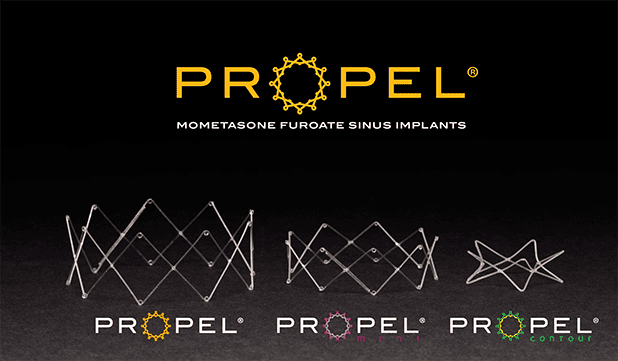The Centers for Medicare and Medicaid Services (CMS) have approved a revised coding application filed by the Company for its family of PROPEL sinus implants (mometasone furoate) used to reduce inflammation and maintain patency following sinus surgery.
Prior to this decision, PROPEL shared a billing code with the Company’s related but therapeutically distinct SINUVA® (mometasone furoate) sinus implant, used to reduce polyps and the need for revision sinus surgery. The approval of this new application establishes a separate code for PROPEL, S1091 “Stent, non-coronary, temporary, with delivery system (propel),” as well as updates the current SINUVA J-Code to, J7402 “Mometasone furoate sinus implant, (sinuva), 10 micrograms.” The Company believes these specific coding assignments, will have a positive impact by improving the accuracy in claims adjudication for both PROPEL and SINUVA, support expanded use in multiple sites of service for both products, provide greater clarity for payers and providers and solidify the current reimbursement environment. CMS will discontinue the original shared Level II HCPCS code J7401 “Mometasone furoate sinus implant, 10 micrograms.” The new PROPEL and SINUVA codes are scheduled to take effect on April 1, 2021.
“We are pleased that CMS recognized the benefit to payers and providers of decoupling the previously shared, and therefore potentially confusing, single J-Code for both SINUVA and PROPEL. These are distinct offerings with different uses and benefits. In addition, SINUVA is classified by FDA as a drug and PROPEL as a device. With the dedicated and updated SINUVA code, J7402, and a specific PROPEL code, S1091, payers can now more accurately delineate and reimburse based upon the specific use of each product. Moreover, Payers can accurately align each product’s National Drug Code (NDC) to the product-specific, CMS-assigned, code and the product’s actual use,” said Thomas A. West, President and Chief Executive Officer of Intersect ENT. “CMS’s agreement, at our request, to assign separate codes to SINUVA and PROPEL reflects and supports our deliberate strategy to leverage Intersect ENT’s proprietary drug-eluting sinus stent technology platform while, at the same time, broadening our portfolio of therapeutic offerings, clinical indications, and health economic data to support evidence-based and cost-effective care across the continuum of need in chronic rhinosinusitis.”
PROPEL® Steroid Releasing Sinus Implants: The PROPEL family of products are the first and only bioabsorbable steroid releasing sinus implants approved by the FDA to maintain patency and locally deliver steroid to the sinus mucosa in patients >18 years of age after sinus surgery. Clinically proven to improve outcomes for chronic sinusitis patients following sinus surgery, PROPEL sinus implants mechanically prop open the sinuses and release mometasone furoate, an advanced corticosteroid with anti-inflammatory properties, directly into the sinus lining then bioabsorb. PROPEL’s safety and effectiveness for use in ethmoid sinuses is supported by Level 1-A clinical evidence from multiple clinical trials, which demonstrates that PROPEL implants reduce inflammation and scarring after ethmoid sinus surgery, thereby lessening the need for post-operative oral steroids and surgical interventions. PROPEL is indicated for the ethmoid sinus; PROPEL Mini is indicated for the ethmoid and frontal sinuses, and PROPEL Contour is indicated for the frontal and maxillary sinuses.
SINUVA® Steroid Releasing Sinus Implant: SINUVA is a non-surgical, corticosteroid-eluting implant for the treatment of nasal polyps in adult patients who have had ethmoid sinus surgery. Its innovative 2-in-1 design incorporates a self-expanding, bioabsorbable implant structure along with the targeted delivery of an anti-inflammatory corticosteroid, mometasone furoate. It provides localized drug delivery for up to 90 days directly to the site of disease. By nature of its design as an office-administered implant with direct delivery of anti-inflammatory medication, SINUVA minimizes the reliance on patient compliance. SINUVA is clinically proven to reduce polyps and the need for revision nasal surgery, as well as improve the symptoms of nasal polyps, nasal obstruction, congestion, and decreased sense of smell.



